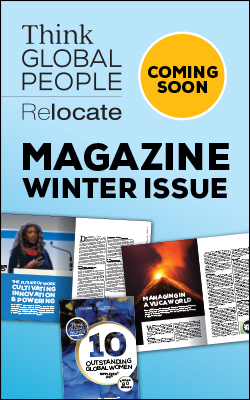How to build a business case for business traveller management
Managing business travellers has always been a complicated process but changes to tax, immigration and security environments are adding to the difficulties. What are some possible solutions?
– the must read for HR, global managers and relocation professionals.
Much has been written recently about the risks associated with short-term business travellers. In the Global HR and Mobility world, the focus of such articles has usually been around the taxation, immigration and duty of care elements.So if we decide that this is a real business problem, how do we go about building a business case to implement such a project?
What's the biggest challenge in managing business travellers?
The single biggest issue in managing business travellers within an organisation is to understand who exactly is responsible for managing those travellers.Let’s look at all of the potential stakeholders that can be impacted by a single travel event and who, as a result, should be part of an internal task force team to deliver the project (see centre panel). Each internal team member can interact with the output of data driven by a business travel event.With so many internal functions to satisfy, each with varying degrees of influence in an organisation, it is easy to understand why it is sometimes seen as hard to achieve.Each of these company functions should have a vested interest in securing data from a managed business traveller programme and therefore it is important to recruit a member from each unit as you build your business case.Top tips for a successful business traveller management programme
There is only one constant in a business travel event – focus on the traveller first
In many companies there are fragmented approaches to managing business travellers. Larger companies have Travel Management teams focused on the booking of travel and the resulting spend levels. Smaller companies allow travellers to book directly with suppliers and set guidelines on the class of travel, level of accommodation etc. The only constant in a business travel event is the business traveller and their smartphone. If you want to manage business travel, you should look to maximise this single consistent data source.Don’t be afraid to rely on the business traveller
One of the most surprising elements I have encountered in talking with countless customers over the last 12 months is their reluctance to involve the traveller or to rely on them to complete processes. This is unusual as we expect travellers to download internal forms or use travel booking engines. If we analyse the output of travel booking engines to monitor compliance, it begs the question: how did that data get there if not from the traveller themselves?I listened intently at a recent business travel conference session as a Mobility Manager said he wouldn’t roll out a technology solution as he couldn’t rely on his people to complete the process, yet he mandates the use of an internal Excel form to capture travel data.Many travel industry reports indicate the wishes of travellers to access company processes via a mobile app rather than internal forms or emails (Business Travel News – Mobile disconnections in the age of smartphones and travel apps). Speaking at the recent HR Tech Conference in Las Vegas Nevada, Josh Bersin, founder of Bersin, Deloitte Consulting LLP, outlined how employees are seeking a new ‘Engagement Layer’ to interact with company systems. This engagement layer will be ‘chat’ or mobile, with connectivity to complex HRIS, Expense or Payroll systems. As these systems evolve, the layers of integration become easier than in the past so encouraging use of mobile systems will ensure greater interaction with and collection of data.Instead of completing complex and repetitive internal form processes you should look to hand your travellers an App/Mobile solution. You equip them with a mobile phone, travel insurance, roaming data plans so why not add one more piece of kit for their international travels?The upcoming millennial generation has always had a smartphone in their hand and even technophobic business travellers are coming around to the use of apps like Uber and Skyscanner to facilitate their international travel.A critical part of implementing a short-term business travel programme is to impress on the traveller that the taxation or immigration impacts are personal. If a traveller is refused entry or is temporarily suspended from entering a country for a visa infraction, it is the traveller’s personal passport and identity that sits on the immigration system. If that traveller leaves the company, the infraction goes with them – it is not expunged when he or she starts to work with a new company.Related articles:
- Agility is key in the ever-evolving world of hospitality
- Visa-free access continues to increase globally
- Demand for travel security advice grows 800 per cent
All tax returns are signed individually by a traveller and a tax liability could arise many years after the travel event. Having accurate information can help to counter a tax demand or audit.Communicating this accurately at implementation will drive far greater adoption of the programme. According to mobile travel company, Travelport Digital, business travellers use on average 16 Apps while travelling, so there is ample room for adoption of your smartphone driven programme.
Maximising data to achieve results
If we are focusing on the traveller then we can use his or her input via smartphone apps to collect the trip data. If travel or expense processes are embedded in a company, mobility professionals are often reluctant to disrupt those processes with the travel or finance teams.In many companies there is an established travel approval and management process. The difficulty for Global Mobility teams is that ‘compliance’ for travel managers has an entirely different meaning.Travel Managers are almost entirely focused on the cost element of the trip or the use of approved suppliers. For them, compliance means ensuring that an employee is booking the correct hotel chain and they will rarely look at the downstream impacts of the trip on taxation, immigration or payroll compliance.Travel Managers that have a managed travel programme do cover the duty of care elements very well, but figures from the Global Business Travel Association (GBTA) show that only 40 per cent of companies have a managed travel programme.If your company has a strong travel management function, work with them to maximise the data they hold within their systems to achieve your requirements.The data necessary to drive taxation and immigration compliance is usually held within these systems. The ability to create API data links with systems like Concur or CWT’s and HRG’s travel booking tool is quite simple. Re-using this data and directing it to a tax or immigration rules engine will remove some of the internal conflicts that can arise when trying to implement short-term business traveller management programmes. By working with your travel or expense colleagues, Mobility can quickly and easily source the data needed to focus on tax or immigration compliance. As Mr Bersin pointed out at the HR Tech Conference, buyers should “demand that vendors integrate with each other.”Seek budget from the multiple stakeholders or resources
Mobility teams are more used to taking cost out of programmes rather than adding cost for a new initiative. Mobilise your internal colleagues and secure elements of their budget to fund the data that can flow back to their units and better help them with their compliance obligations.Payroll, Finance and Tax units usually command more power when new projects are commissioned, so look to secure that budget to assist with the programme rollout. The elusive ROI can be achieved when you are measuring benefits across multiple business units – all coming from a single travel event. A project is more likely to be approved if five or six stakeholders are arguing for it at the onset.Many companies employ temps to manage manual reporting – parsing travel system outputs or sign in and out sheets to determine who is where but implementing a fixed cost technology alternative is the perfect solution – especially if it results in a cost saving. Projects that are unclear about the final cost can be difficult to approve.Raise the profile of the mobility team
Many mobility teams are reactive to the downstream tax or immigration impacts of short-term business travel. Too often they are called in to resolve difficulties after the transgression has occurred. By implementing a real time programme – either with smartphone input by the traveller or by using travel agency data – the mobility teams can provide timely advice in how to manage visas, withholding or Permanent Establishment issues.Mobility teams can easily move to becoming better internal suppliers to their lines of business by reacting in advance to potential tax and immigration risks.More articles from the Autumn issue of Relocate magazine:
Tax, immigration and security challenges
Tax, immigration and duty of care are approaching a perfect storm. This is a critical catalyst in mobilising the internal team necessary to deliver a company wide business traveller management programme.Global tax rule changes sparked by the OECD Base Erosion and Profit Shifting Project, and the renewed focus by the EU and other jurisdictions seeking to tax corporates in the markets where they create value, have brought a significant focus on needing to know where your people are – and what they are doing in that jurisdiction.The Trump administration focus on immigration and the future implications of Brexit mean there is greater scrutiny of business travellers entering jurisdictions to ensure they are travelling on the correct visa. Maverick travellers that push the limits of Visa Exemptions can be brought into line by implementing a business traveller programme under this new geo-political environment. The opportunity to introduce pre-trip assessment will be better received in this new world, as even the most maverick of business travellers do not want to be refused entry or detained.The global security situation and the increase in intensity of natural disasters and security events forces employers to focus on being able to locate travellers in case of emergency.Business travel - conclusion
- Involve the traveller and use smartphone technology to collect data or merge it with existing travel or expense data
- Expand the focus of the project by mobilising the other internal stakeholders affected by business travel events. Support their requirements with the accrued data
- Use the project to raise the stature of the mobility team, establishing them in a greater advisory role
- Harness the changing political environment to mobilise your team
Relocate’s new Global Mobility Toolkit provides free information, practical advice and support for HR, global mobility managers and global teams operating overseas.
 Access hundreds of global services and suppliers in our Online Directory
Access hundreds of global services and suppliers in our Online Directory
©2025 Re:locate magazine, published by Profile Locations, Spray Hill, Hastings Road, Lamberhurst, Kent TN3 8JB. All rights reserved. This publication (or any part thereof) may not be reproduced in any form without the prior written permission of Profile Locations. Profile Locations accepts no liability for the accuracy of the contents or any opinions expressed herein.








































